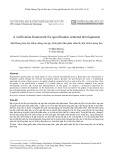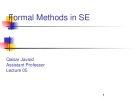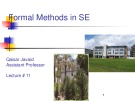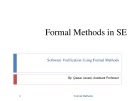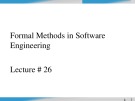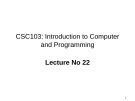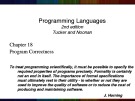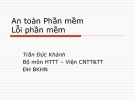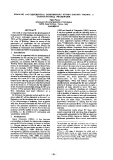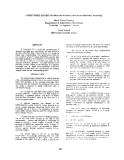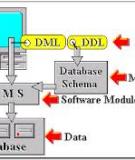
Formal verification
-
This is the general subject of Software Quality Engineering, which is organized into three major topics: Software testing as a primary means to ensure software quality; Other alternatives for quality assurance (QA), including defect prevention, process improvement, inspection, formal verification, fault tolerance, safety assurance, and damage control; Measurement and analysis to close the feedback loop for quality assessment and quantifiable improvement.
 441p
441p  zizaybay1103
zizaybay1103
 29-05-2024
29-05-2024
 1
1
 1
1
 Download
Download
-
Ebook Professional penetration testing creating and operating a formal hacking lab: Part 2 includes contents: Chapter 9: information gathering, chapter 10: vulnerability identification, chapter 11: vulnerability verification, chapter 12: compromising a system and privilege escalation, chapter 13: maintaining access, chapter 14: covering your tracks, chapter 15: reporting results, chapter 16: archiving data, chapter 17: cleaning up your lab, chapter 18: planning for your next pentest.
 288p
288p  longtimenosee05
longtimenosee05
 31-03-2024
31-03-2024
 3
3
 0
0
 Download
Download
-
Part 2 book "Software engineering - A practitioner's approach" includes content: Quality concepts; review techniques; software quality assurance; software testing strategies; testing conventional applications; testing object oriented applications; testing web applications; formal modeling and verification; software configuration management; product metrics,... and other contents.
 505p
505p  muasambanhan05
muasambanhan05
 16-01-2024
16-01-2024
 2
2
 0
0
 Download
Download
-
In the paper "A verification framework for specification centered developments", we propose a verification framework for specification centered developments. In this framework, we firstly focus on improve the quality of specification then use such high-quality specification to drive the verification of the design and the implementation. This framework could be applied in domain of reactive systems with high automation, adaptation, and practicality.
 12p
12p  runordie2
runordie2
 06-06-2022
06-06-2022
 9
9
 2
2
 Download
Download
-
In this chapter, the following content will be discussed: Software reliability, what are formal methods? typical situation, some concerns, some exaggerations, the unbearable easiness of grading, different types of software, verification methods,...
 36p
36p  larachdumlanat126
larachdumlanat126
 31-12-2020
31-12-2020
 11
11
 2
2
 Download
Download
-
In this chapter, the following content will be discussed: How can we check the model? What properties can we check? How to perform the checking? If it is so good, why learn deductive verification methods? If it is so constrained, is it of any use? Depth first search, start from an initial state, how can we check properties with DFS?...
 74p
74p  larachdumlanat126
larachdumlanat126
 31-12-2020
31-12-2020
 14
14
 1
1
 Download
Download
-
Lecture Formal methods in software engineering: Software verification using formal methods. In this chapter, the following content will be discussed: Formal methods in block handler, data invariant, block handler, block handler, selection criteria, formal clean room software engineering,...
 21p
21p  larachdumlanat126
larachdumlanat126
 31-12-2020
31-12-2020
 15
15
 2
2
 Download
Download
-
In this chapter, the following content will be discussed: Conditional correctness, weakest pre-condition, broad CAT of statements, assignment axiom, rules for sequential composition, rules for conditional,...
 25p
25p  larachdumlanat126
larachdumlanat126
 31-12-2020
31-12-2020
 12
12
 1
1
 Download
Download
-
In this section, we introduce the features of JML as they apply to the formal specification and verification of an individual function, such as the Factorial function that we specified and verified by hand in the previous section. We also show how JML allows us to specify run-time exceptions, providing a more robust vehicle than the pure Hoare triples in a real computational setting where exceptions actually occur.
 20p
20p  larachdumlanat122
larachdumlanat122
 26-11-2020
26-11-2020
 17
17
 1
1
 Download
Download
-
Chapter 18b - Formal Methods Tools: JML. In this section, we introduce the features of JML as they apply to the formal specification and verification of an individual function, such as the Factorial function that we specified and verified by hand in the previous section. We also show how JML allows us to specify run-time exceptions, providing a more robust vehicle than the pure Hoare triples in a real computational setting where exceptions actually occur.
 21p
21p  thiendiadaodien_8
thiendiadaodien_8
 24-02-2019
24-02-2019
 24
24
 1
1
 Download
Download
-
This paper proposes an OCL-based framework for model transformations. The formal foundation of the framework is the integration of Triple Graph Grammars and the Object Constraint Language (OCL). The OCL-based transformation framework offers an on-the-fly verification of model transformations and means for transformation quality assurance.
 16p
16p  truongtien_09
truongtien_09
 10-04-2018
10-04-2018
 28
28
 4
4
 Download
Download
-
Bài giảng "Mật mã và ứng dụng: An toàn phần mềm, lỗi phần mềm" cung cấp cho người học các kiến thức: Một số lỗi phần mền thường gặp, các biện pháp an toàn (kiểm thử (Testing), kiểm định hình thức (Formal Verification), lập trình an toàn (Secure Coding)). Mời các bạn cùng tham khảo.
 34p
34p  doinhugiobay_04
doinhugiobay_04
 27-11-2015
27-11-2015
 95
95
 8
8
 Download
Download
-
This work is concerned with the development of instruments for GB parsing. An alternative to the well known indexation system of (Chomsky, 1981) will be proposed and then used to formalize the view of Binding Theory in terms of the generation of constraints on the referential properties of the NPs of a sentence. Finally the problems of verification and satisfiability of BT will be addressed within the proposed framework.
 6p
6p  buncha_1
buncha_1
 08-05-2013
08-05-2013
 38
38
 3
3
 Download
Download
-
A framework for a structured representation of semantic knowledge (e.g. word-senses) has been defined at the IBM Scientific Center of Roma, as part of a project on Italian Text Understanding. This representation, based on the conceptual graphs formalism [SOW84], expresses deep knowledge (pragmatic) on word-senses. The knowledge base data structure is such as to provide easy access by the semantic verification algorithm. This paper discusses some important problem related to the definition of a semantic knowledge base, as depth versus generality, hierarchical ordering of concept types, etc.
 9p
9p  buncha_1
buncha_1
 08-05-2013
08-05-2013
 56
56
 1
1
 Download
Download
-
Assurance technology: Develop a sound scientific and technological basis, including formal methods and computational frameworks, for assured design, construction, analysis, evaluation, and implementation of reliable, robust, safe, secure, stable, and certifiably dependable systems regardless of size, scale, complexity, and heterogeneity; develop software and system engineering tool capabilities to achieve application and problem domain-based assurance, and broadly embed these capabilities within the system engineering process; reduce the effort, time, and cost of assurance (“aff...
 119p
119p  nhacsihuytuan
nhacsihuytuan
 13-04-2013
13-04-2013
 56
56
 7
7
 Download
Download
-
Specific software programs denoted in the Conformed RFP for use by design are considered validated and do not need to be verified. Upon written request, WSDOT can specify other programs that do not require formal verification. All other commercially available software programs shall be verified and added to the Verified Computer Program Log for the project, as noted below. Verification of Spreadsheets. Internally developed spreadsheets may be used.
 30p
30p  tainhacmienphi
tainhacmienphi
 25-02-2013
25-02-2013
 39
39
 4
4
 Download
Download
-
VERIFICATION USING TIMED AUTOMATA Finite automata and temporal logics have been used extensively to formally verify qualitative properties of concurrent systems. The properties include deadlock- or livelock-freedom, the eventual occurrence of an event, and the satisfaction of a predicate. The need to reason with absolute time is unnecessary in these applications, whose correctness depends only on the relative ordering of the associated events and actions.
 25p
25p  vaseline
vaseline
 23-08-2010
23-08-2010
 82
82
 8
8
 Download
Download
-
ANALYSIS AND VERIFICATION OF NON-REAL-TIME SYSTEMS A great collection of techniques and tools are available for the reasoning, analysis, and verification of non-real-time systems. This chapter explores the basic foundations of these techniques that include symbolic logic, automata, formal languages, and state transition systems. Many analysis and verification techniques for real-time systems are based on these untimed approaches, as we will see in later chapters.
 31p
31p  vaseline
vaseline
 23-08-2010
23-08-2010
 76
76
 9
9
 Download
Download
CHỦ ĐỀ BẠN MUỐN TÌM











